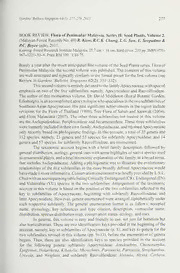
Flora of Peninsular Malaysia. Series II: Seed Plants, Volume 2. R. Kiew, R.C.K. Chung, L.G. Saw, E. Soepadmo & P.C. Boyce (eds). 2011 PDF
Preview Flora of Peninsular Malaysia. Series II: Seed Plants, Volume 2. R. Kiew, R.C.K. Chung, L.G. Saw, E. Soepadmo & P.C. Boyce (eds). 2011
Gardens BulletinSingapore64(1):277-278. 2012 277 BOOK REVIEW. Flora of Peninsular Malaysia. Series Q: Seed Plants. Volume 2. (Malayan Forest Records No. 49) R. Kiew, R.C.K. Chung, L.G. Saw, E. Soepadmo & RC. Boyce (eds). 2011. Kepong: Forest Research Institute Malaysia. 25.7 cm * 18 cm. hardcover. 235 pp. ISBN 978- 967-5221-53-8. Price RM 100 / USS 75. Barely ayearafterthe much anticipated first volume ofthe Seed Plants series. Flora of Peninsular Malaysia, the second volume was published. The contents ofthis volume arewell structured and typically conform to the format preset for the first volume (see Review in Gardens 'Bulletin. Singapore 62(2): 331-332). ThissecondvolumeisentirelydevotedtothefamilyApocynaceae.withspecial emphasis on two ofthe five subfamilies, namely. Apocynoideae and Rauvolfioideae. The author ofthis momentous volume. Dr. David Middleton (Royal Botanic Garden. Edinburgh),isanaccomplishedapocynologistwhospecialisesinthetwosubfamiliesof SoutheastAsianApocynaceae. His past significant achievements in the region include revisions for the Flora ofThailand 1999). Tree Flora ofSabah and Sarawak (2004). ( and Flora Malesiana (2007). The other three subfamilies not treated in this volume are the Asclepiadoideae. Periplocoideae and Secamonoideae. These three subfamilies wereformerlyincludedintheirown family,Asclepiadaceae. andrejoinedApocynaceae only recently based on phylogenetic findings. In this account, a total of35 genera and 112 species, namely. 21 genera and 55 species for subfamily Apocynoideae. and 14 genera and 57 species for subfamily Rauvolfioideae. are enumerated. The taxonomic account begins with a brief family description, followed by general distribution, ecology, general uses with some highlights ofnative species used as ornamental plants, and abrieftaxonomic explanation ofthe family, in abroad sense, that includesAsclepiadaceae. Adding a phylogenetic tree to illustrate the evolutionary relationships ofthe five subfamilies in the more broadly defined Apocynaceae would havemadeitmoreinformative.Conservationassessmentwasbriefly providedbyL.S.L. ChuawithanaccompanyingtablelistingCriticallyEndangered(CR).Endangered(EN) and Vulnerable (VU) species in the two subfamilies. Arrangement ofthe taxonomic account in this volume is based on the position ofthe two subfamilies reflected in the key to subfamilies of Apocynaceae. beginning with subfamily Rauvolfioideae. and laterApocynoideae. However, genera enumerated were arranged alphabetically under each respective subfamily. The general enumeration format is as follows: accepted name, etymology, key references and type citation, description, vernacular name, distribution, species distribution map. conservation status, ecology, and uses. In general, this volume is easy and friendly to use. notjust for botanists but also horticulturists. There are two identification keys provided at the beginning ofthe account, namely, key to subfamilies ofApocynaceae (p. 8), and key to genera for the two subfamilies revised in this volume (pp. 9-13). before the enumeration ofgenera begins. Then, there are also identification keys to species provided in the account for the following genera: subfamily Apocynoideae: Anodendron. Chonemorpha. Epigynum. Holarrhena. Kibatalia, Micrechites, Parameria, Parsonsia, Strophantlms. Urceola, and Wrightia; and subfamily Rauvolfioideae: Alsionia, Alyxia, Cerbera. 278 Card.Bull. Singapore64(1)2012 Chilocarpus,Kopsia(also keytovarieties ofKopsiagriffithii),Leuconotis, Melodimts, Rauvolfia, Tabemaetnontana, and Willughbeia. In addition to that, this volume is also well illustrated with 15 colour plates provided at the end ofthe account and also 36 line drawings distributed throughout the book for the various genera. AstheFloraofPeninsularMalaysiateamispickingupitspacetodocumentand disseminate information of Peninsular Malaysian plants to the scientific community, we eagerly look forward to the next volume. Y.W. Low Singapore Botanic Gardens
